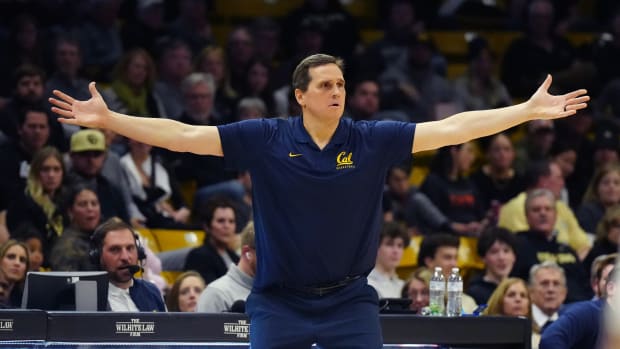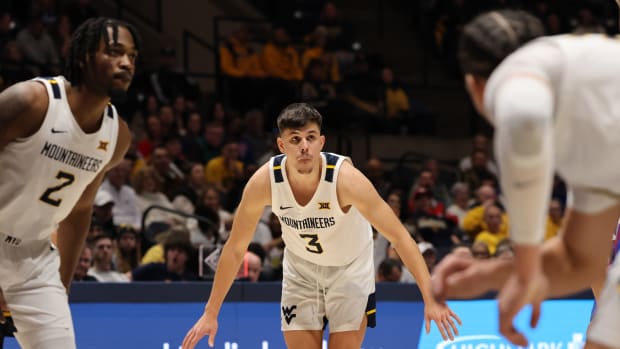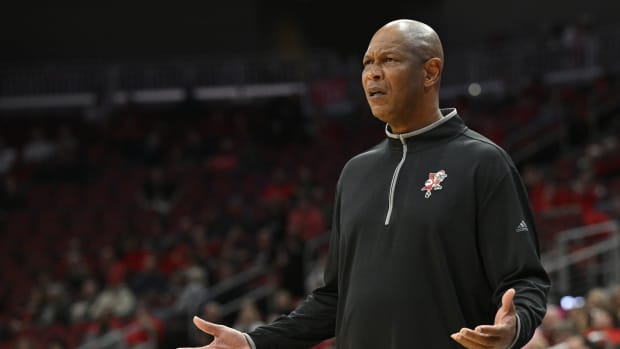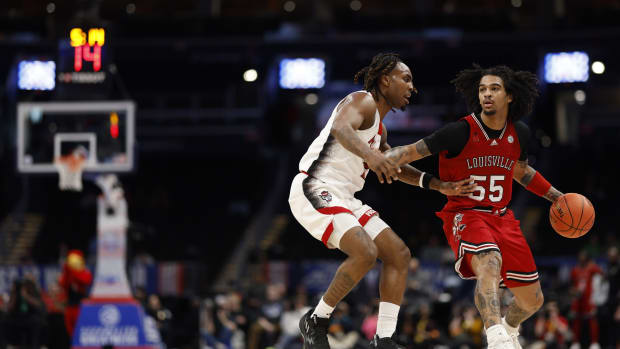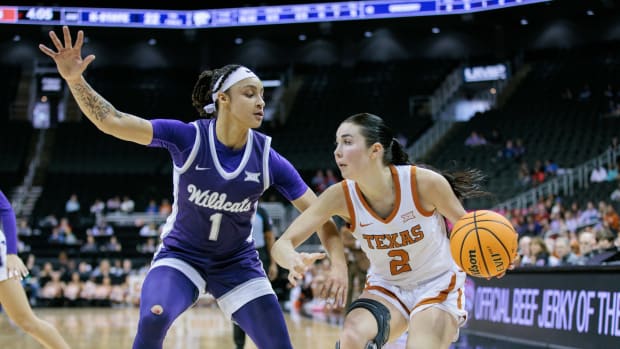Mail: Why scores of college coaches will wear a blue puzzle pin this weekend
Note: Seth Davis will periodically answer questions posed to him over Twitter, Facebook and emails sent through SI.com. Be sure to check out his Hoop Thoughts column every Monday and to send questions during his Twenty for Tuesday Q&A on Twitter at @SethDavisHoops. Trolls not included. Questions may be edited for clarity.
The first time I ever noticed the blue puzzle piece symbol that is used to promote autism awareness, it was pinned to the lapel of then UConn coach Jim Calhoun’s suit coat. The image was created to represent the complexities of a disorder that affects one out of every 68 American children. Calhoun wore the pin in support of his grandson, who was diagnosed with the disorder at the age of two. Having never seen that pin before, I was interested to learn what it was and why Calhoun wore it. It enhanced my own understanding of autism.
That’s the way these things often work. Someone is personally touched by adversity, and instead of wallowing in despair, that person uses whatever tools are available to help not just his or her loved one, but also others who are fighting the same battle. Because of a similar effort by a pair of other coaches who are likewise touched by autism, this weekend several hundred college basketball coaches and broadcasters will wear the blue puzzle piece on their suit coats as well. The campaign is called “Coaches Powering Forward for Autism.”
The two men—the two fathers—behind this effort are Pat Skerry, the head coach at Towson University, and Tom Herrion, who is an assistant at TCU. Many years ago, Skerry and Herrion worked on the same staff Pittsburgh. When both had sons who were diagnosed with autism, they shared their experiences and insights, and eventually talked about ways they could create more awareness. They started by wearing the puzzle pins themselves, but it wasn’t long before they enlisted their colleagues’ help. The Coaches Powering Forward program is now in its fifth year, and it has grown from just a few dozen participants to where it is today. It is done in conjunction with Autism Speaks, an organization that was formed to educate the public and raise money to aid research and help families cope.
“We don’t actively solicit money. It’s more like an awareness campaign,” Skerry told me by phone this week. “For our game, it’s always the biggest crowd of the year. We have a lot of different groups and organizations who come out. But it’s great coming home and watching the games on TV and seeing all the big-timers wearing the pins. That's pretty cool.”
Skerry and Herrion are warriors in this cause. They split up a long list of coaches and broadcasters, reach out to them by text and mail them the pins. “I’d love to figure out long-term how we can get a nonconference game like the Coaches Versus Cancer thing where you get some of the bigger schools to play,” Skerry said. “We haven’t figured that out yet, but I get great satisfaction out of seeing this slowly build momentum.”
One of the results of these efforts is that Herrion and Skerry are working to help their respective sons, Robert and Owen, in a very public way. They get asked how the boys are doing all the time. Skerry is fortunate that he and his wife are able to provide Owen with the care he needs, including private therapy at home twice a week to help him with socialization and other behaviors. He told me that Owen is a huge basketball fan who loves to shoot on the hoop in his living room. Owen has made significant progress since he was diagnosed with the disorder, but there is still much work to be done.
“There’s a saying that if you know one person with autism, you know one person with autism. Every case is different,” Skerry said. “My son still struggles with speech. Your children usually outlast you as a parent. So you have concerns like, is he going to be able to hold a job? Is he going to get married? Who’s going to take care of him? That’s a big concern for any parent, but for the parent of a child with autism, it can be even more magnified.”
All the families who deal with these issues can thank Skerry and Herrion for holding up a magnifying glass to this cause. Their Coaches Power Forward program brings awareness, education and, hopefully, some comfort to all the other families who share their journey with autism. If you want to learn more about this disorder and how you can help, I encourage you to visit autismspeaks.org. And as you’re enjoying your games this weekend, be sure to take note of all those blue puzzle piece pins. They serve as healthy reminders of the millions of families who are fighting this fight and could use all the teammates they can get.
Now on to the Twitterbag. . . .
What is Wisconsin’s ceiling? — Phil Shaw (@MrClarasDad)
I chose this question because I have seen Wisconsin play in person twice this year. The Badgers may be ranked No. 10 in this week’s AP poll, but I still believe people are sleeping on them. If I like what I see in the bracket, I would love to pick them to go to the Final Four during the CBS selection show.
Why? I’ll give you three reasons. First—and most obviously—they have very good players. Ethan Happ is giving Purdue’s Caleb Swanigan a run for Big Ten player of the year. Happ, a sophomore center, just turned in his finest performance at the school by going for 32 points, six rebounds, four steals, three assists and two blocks in the Badgers’ overtime win at Rutgers last Saturday. And no, I don’t discredit Wisconsin because it needed OT to beat a bad team. Quite the contrary. The Badgers were on the road (well, at Madison Square Garden anyway), having an off day and playing against an inspired opponent—yet they still found a way to win. We all know what senior forward Nigel Hayes is capable of, and there is no better clutch shooter in the country than senior guard Bronson Koenig. Not many teams can boast three starters with NBA potential and so much experience.
Bracket Watch: How the field looks after a week of upsets
Second, Wisconsin leads the nation in a category that Ken Pomeroy calls “Minutes Continuity.” This is a comparison between the number of minutes guys played last season and what they are doing this year. In other words, Wisconsin has had basically the same starting five for two straight seasons—and last year the Badgers reached the Sweet Sixteen. Since they’ve had no major injuries (knock on wood) they have used the same starting lineup for every game this season. They usually don’t overwhelm teams, but they are at their most comfortable when the game gets late and the score is close. That’s a huge asset to carry into March.
Finally, I like that they deploy a highly unusual offensive system. Consider that Hayes is the team’s leader in assists at 3.1 per game, and Happ is second at 2.8 per game. That’s right—the power forward and the center are the top two assists guys. I don’t know that I’ve ever seen that. Those guys get the ball in the post and operate on the baseline, where they can see the entire floor and make good decisions.
I guess that’s a long way of saying that this team’s ceiling is located in Phoenix, Arizona. Don’t be surprised if that’s where Wisconsin's season ends.
What is the key to Michigan State turning it around? — Tony Goose (@Tony_Goose)
This is a tough subject for me because I gave the Spartans my coveted Buy-Plus rating in my annual Hoop Thoughts Stock Report. At the time they were unranked, and my confidence in their ascent stemmed from three things:
First, they were playing without freshman forward Miles Bridges, who had suffered an ankle injury. Second, their coach is Tom Izzo.
Bridges came back, and though it took him a couple of games, he has rediscovered the form he showed before he went out. Last week, he scored 33 points (to go along with seven rebounds and four blocks) in a loss at home to Purdue. He followed that up with 15 points and 13 rebounds in Sunday’s critical win over Michigan. And yes, Izzo is still Izzo.
But there was a third reason I like the Spartans—namely, I believed their perimeter players would improve because, frankly, they could hardly play worse. Unfortunately, this has not been the case. The main culprit is senior Eron Harris, who was the team’s leading returning scorer from last season but has proven incapable of carrying the Spartans like so many great guards have done in the past. Freshman Cassius Winston has played well at times, but he has never totally overtaken junior Tumtum Nairn at the point, which Izzo told me he thought could happen when I saw the Spartans play at the Battle 4 Atlantis back in November. Sophomore Matt McQuaid may have been a great shooter in high school, but he has not improved over his freshman season. If anything, he has regressed, thanks partly to his having missed the entire off-season while recovering from hernia surgery. Nairn is super quick and a terrific leader, and he might be the most likeable player in the country. But he is still a horrendous outside shooter (37.5% from three) who is making just 47.4% of his free throws.
No, I’m not giving up on this team, but at some point, the Spartans are who they are. Michigan State will have a hard time scrapping and clawing its way into the NCAA tournament, but even if does, I don’t see the Spartans sticking around for long. Sorry, shoppers.
Bubble Watch: Power conferences crowding the NCAA tournament field
If Arizona wins the Pac-12 regular season and tournament and Gonzaga goes undefeated, who would get the No. 1 seed in the West? — Pat McLaughlin (@pmac520)
Terrific question, and an important one. If this is the scenario that plays out, then both of these teams will almost certainly be No. 1 seeds. But since only one of those teams can play in San Jose, then the committee would have a very important choice to make as to which one stays close to home. I’d argue that Arizona, UCLA and Oregon are better off failing to win the Pac 12 so they could remain as a No. 2 seed, which would give them the chance to stay out West opposite Gonzaga.
The key factor is not so much whether Arizona wins the Pac-12 regular season and tournament but whether it can get to Selection Sunday without losing another game. That is doubtful given the caliber of competition, but if that were the case, then Arizona’s record against the top 50 teams in the RPI could be 10–2, assuming two of its opponents in the conference tournament fall into that category. Gonzaga’s, on the other hand, would be 8–0, with three of those wins coming against Saint Mary’s, the only other WCC team that is currently ranked in the top 50.
We should also remember that when the two teams played in Anaheim back on Dec. 3, Gonzaga won, 69–62. Yes, that was well before sophomore guard Allonzo Trier rejoined the Wildcats, but if their résumés are super duper close, that result could well be a difference maker.
In the end, I stand by my argument that if Gonzaga is undefeated heading into the tournament, then it will be impossible to deny the Zags a No. 1 seed. If Arizona also runs the table from here, then it is highly likely that the Wildcats would also be a No. 1. So one of them would be shipped to another area of the country. Again, I would lean towards giving the edge to perfection, but it would be a very close call.
Can you see coach Kevin Keatts and UNCW running the table? — Maureen Martindale (@mojerzgirl)
The Seahawks did lose their first CAA game last weekend at William & Mary, but this is exactly the type of team that the big boys will want to avoid early in the bracket. In the first place, the Seahawks have NCAA tournament experience. Last year, UNC Wilmington gave Duke fits before losing by eight points. Four of those starters returned, and now UNC Wilmington enters this week with just three losses on its résumé—to William & Mary, to Middle Tennessee on a neutral court, and at Clemson.
I love this team’s experience and efficiency. I don’t love that it lacks a legit big man. The Seahawks are better than they were offensively last year but not as good defensively. It’s worth noting, however, that they have improved somewhat on their most glaring deficiency—namely, a propensity to foul. Last season, they were ranked second to last in the country in defensive free throw rate. That really cost them in the Duke game, when the Blue Devils attempted 43 free throws to UNC Wilmington’s 19. This year the Seahawks are ranked 247th in that category.
It’s also worth nothing that Kevin Keatts is a Rick Pitino disciple. In his two-plus seasons on the sidelines, Keatts has led the Seahawks to a 63–25 record. This is his best team so far, and while running the table is not impossible, the more intriguing question is whether this team could earn an at-large bid if it loses in the conference tournament. Allow me to go on record as predicting that if UNC Wilmington wins its remaining games but falls in the CAA tournament final, then it will be in the field of 68. But we’ve got a long way to go.



